Exercises (2276)
Einstein
Light-Contact
Partner work

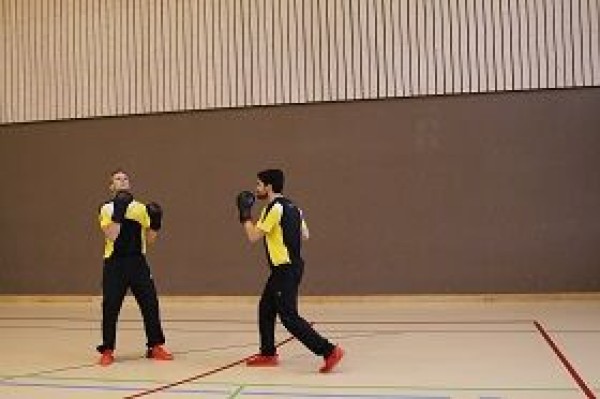

Two participants stand on two lines about 5 metres apart. One participant calls out an addition with two-digit numbers (e.g. "34 plus 23") and then runs to their opponent to score a hit. If he scores before the attacked player can complete the task, he receives one point. The defender receives a point if he states the result before he is hit. In the next round, the roles are swapped. Who has scored a certain number of points first or has scored more points after a certain time?
Variant:
Only shoulder and torso hits are counted.
Participant:
1 pair of boxing gloves
Move your elbows backwards while standing
Power
Individual work
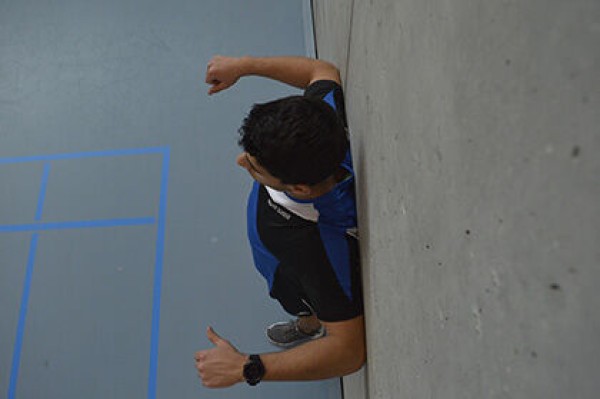

Stand leaning diagonally against the wall (back against the wall), arms bent at the side at shoulder height (hands facing forwards), push your elbows back (upper body away from the wall) and return to the starting position.
Attention:
Do not rest your shoulder blades completely on the wall.
Lighten:
Stand upright.
Harden:
Foot further away from the wall (increase the incline).
1 wall
Move your elbows forwards while standing
Power
Individual work
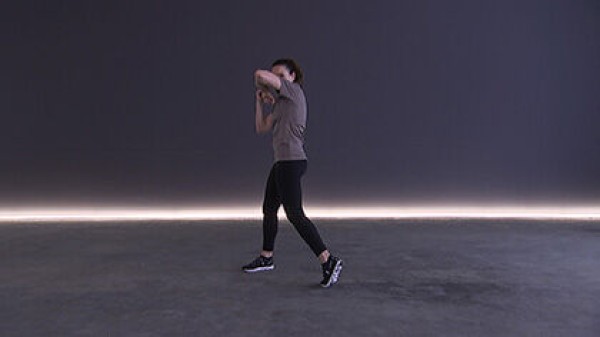
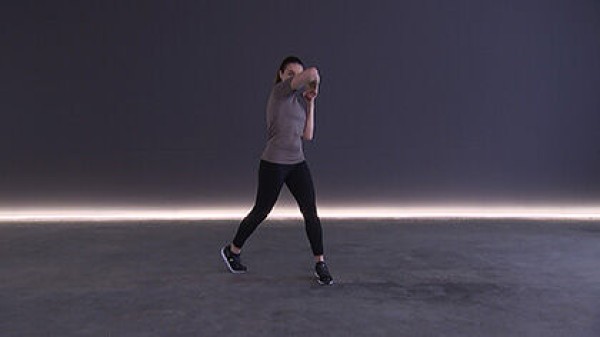
A distinction is made between the left-handed and right-handed stance. Right-handers take the left stance (left foot in front), while left-handers take the right stance (right foot in front). The left-hand stance: The left foot is placed one step forwards from a parallel stance approximately shoulder-width apart so that the right hand is behind. The right hand corresponds to the striking hand, the left hand to the leading hand. The distance between the two feet is approximately one shoulder width, with the feet on a diagonal to each other. The front foot stands on the entire sole, the heel of the back foot is raised. Both feet point forwards and the weight is evenly distributed over both legs. The front shoulder is turned slightly inwards. The whole body is slightly crouched, the knees are slightly bent and soft. The striking hand is placed in front of the chin and rests against the body. The lead hand is in front at eye level. The fists point outwards with the back. The arms are in front of the body and the elbows point downwards so that the arms cover the body.
Alternate between bringing one elbow forwards at eye level (pointing forwards/upper arm in the direction of your gaze) and turning your upper body with it.
Attention:
Always hold your arms up (chin or eye level).
Lighten:
Lower your elbows forward (chest height).
Harden:
Hold additional weight on your arms or in your hands.
2 weight cuffs/weight balls/dumbbells ► make the exercise more difficult (additional weight)
Bring elbows and knees together crosswise while seated alternating ► rotational crunch
Power
Individual work
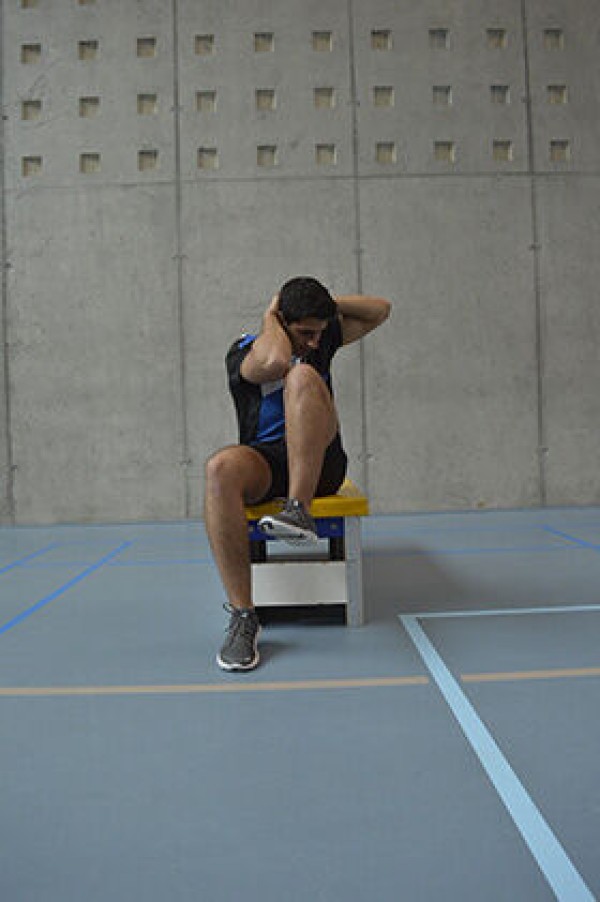
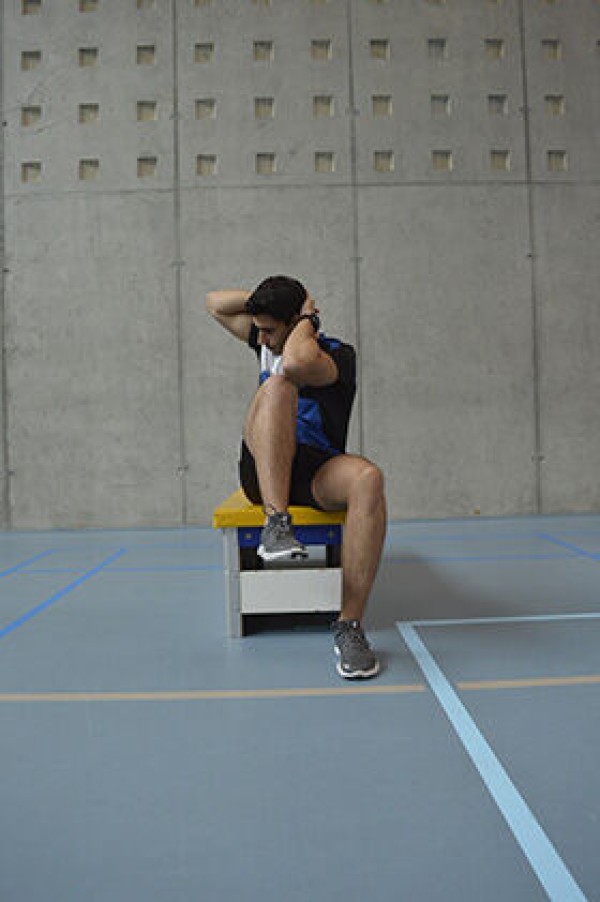
Sit upright on the Swedish box (or a long bench), place your arms bent next to your head (hands on the back of your neck), bring your elbows and knees together by lifting each leg and lowering your upper body crosswise in front of your stomach. Switch sides after each exercise.
Attention:
Do not fold your elbows together/bring them in front of your face.
Lighten:
Do not bring your elbows and knees fully together.
Harden:
Add weight to your legs.
2-3 vaulting box elements (incl. top section) or 1 long bench
2 weight cuffs ► to make the exercise more difficult (additional weight)
Bring your elbows and knees together crosswise while standing (left) ► step up
Power
Individual work
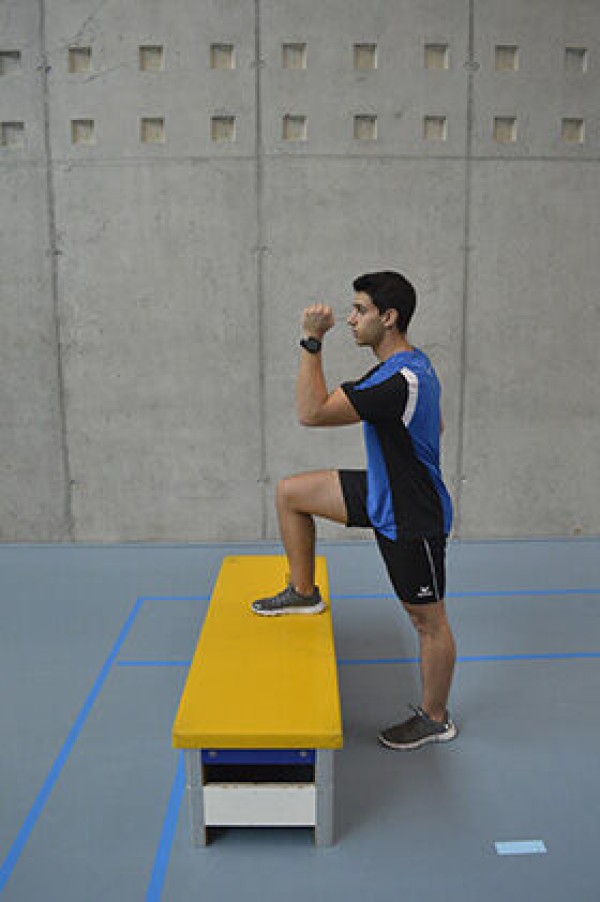

Stand on one leg in front of the swinging box elements/long bench (left), place the other (right) leg on the top of the swinging box/long bench, step onto the box element/long bench and simultaneously bring the knee of the swinging leg together with the opposite elbow crosswise, then return directly to the starting position.
Attention:
Keep your back straight, keep the knee of the supporting leg centred over the foot (do not bend forwards).
Lighten:
Lower element (upper part of the swinging box only) or no element at all.
Harden:
Additional weight on the feet, higher element.
2 vaulting box elements (incl. top section) or 1 long bench
2 weight cuffs ► make the exercise more difficult (additional weight)
1-2 additional box elements ► make the exercise more difficult (position)
Bring elbows and knees together crosswise while standing (right) ► step up
Power
Individual work


Stand on one leg in front of the swinging box elements/long bench (right), place the other (left) leg on the top of the swinging box element/long bench, step onto the box element/long bench and simultaneously bring the knee of the swinging leg together with the opposite elbow crosswise, then return directly to the starting position.
Attention:
Keep your back straight, keep the knee of the supporting leg centred over the foot (do not bend forwards).
Lighten:
Lower element (upper part of the swinging box only) or no element at all.
Harden:
Additional weight on the feet, higher element.
2 vaulting box elements (incl. top section) or 1 long bench
2 weight cuffs ► make the exercise more difficult (additional weight)
1-2 additional box elements ► make the exercise more difficult (position)
Bring elbow and knee together crosswise in standing position alternating ► knee to elbow
Power
Individual work
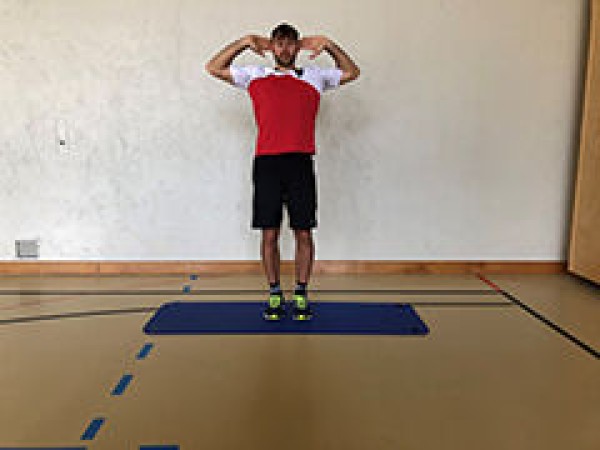
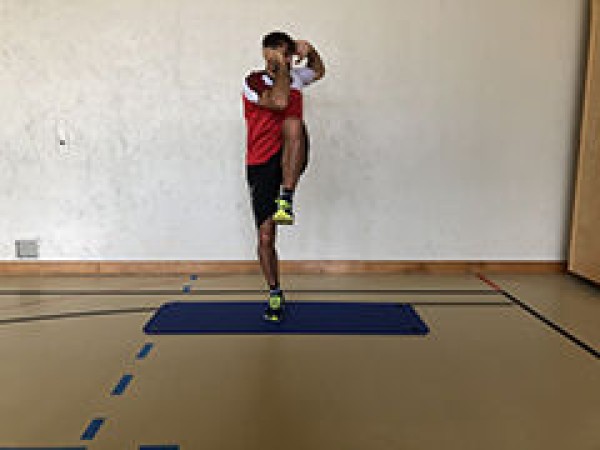
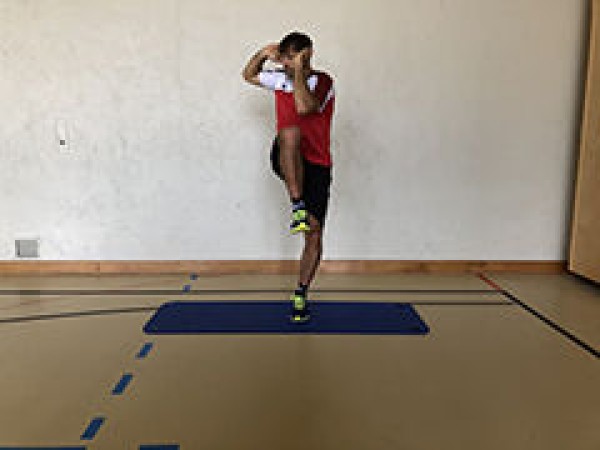
With your arms bent and hands locked behind your head (elbows pointing to the side), bend one leg and lift it up while rotating your upper body to move the elbow crosswise to the raised knee (upper body remains upright). Then return to the starting position and perform the exercise with the other arm and leg.
Lighten:
Lift the leg less high (without bringing the elbow and knee together).
Harden:
Add weight to the feet.
2 weight cuffs ► make the exercise more difficult (additional weight)
Bring elbows and knees together crosswise in four-footed stance alternating ► quadruped reach
Power
Individual work


Stand on four feet, stretch one arm and one leg crosswise, bring knees and elbows together under the body (approximately chest height) and return to the starting position (without lowering). Switch sides after each exercise.
Attention:
Head, torso, hips and leg (and outstretched arm) form roughly one line.
Lighten:
Do not raise arms and legs to a horizontal position.
Harden:
Hold additional weight on the legs/arms and/or in the hands.
2-4 weight cuffs/2 weight balls/dumbbells ► make the exercise more difficult (additional weight)
Bring elbows and knees together crosswise in supine position ► rotational crunch
Power
Individual work


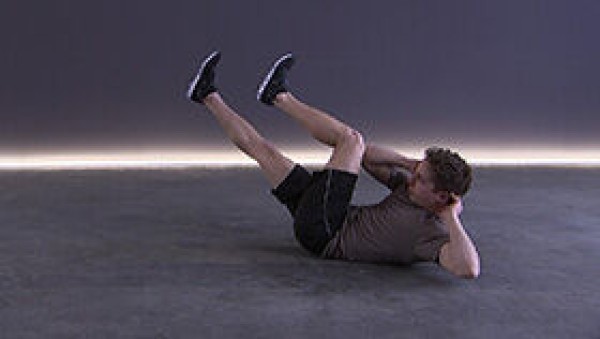
Lie on your back, arms bent next to your head, upper body slightly raised (shoulder blades off the floor), legs stretched out and slightly raised, bring one elbow and one knee together crosswise (approximately at navel height). Switch sides after each exercise.
Attention:
Do not lower your upper body completely (constant tension), do not pull your head with your hand (place your hand next to your ear).
Lighten:
Do not bring your elbows and knees fully together (smaller range of motion); only hold the starting position.
Harden:
Hold your arm outstretched in a high position (in extension of your body) towards your knee; add weight to your arms and/or legs.
2-4 weight cuffs/2 dumbbells ► make the exercise more difficult (additional weight)
Explanation of the exercises/items/test forms
Miscellaneous
The sports leader explains the various exercises/posts or test forms to the participants and points out the correct execution (including organisational instructions) as well as possible misalignments/error patterns.
First steps
Coordination exercises
Individual work
Once you have mastered the basic position, you can try your first steps. It is important to feel the strap with the forefoot before putting the whole foot down. This means you don't have to look at the strap to know where it is. Before you remove the back foot from the strap, you should place it on your toes to shift your centre of gravity to the front foot.
Easier:
Stretch the slackline tightly over a short distance (3-5m); help a partner by holding their hand (always go with the balancing movement and only stabilise when the slackliner is almost falling).
Harder:
Walk backwards; stretch the slackline over a long distance.
1 Slackline
Extension of the arms on a slope (pull-up position / passive slope) ► dead hang / passive hang
Power
Individual work
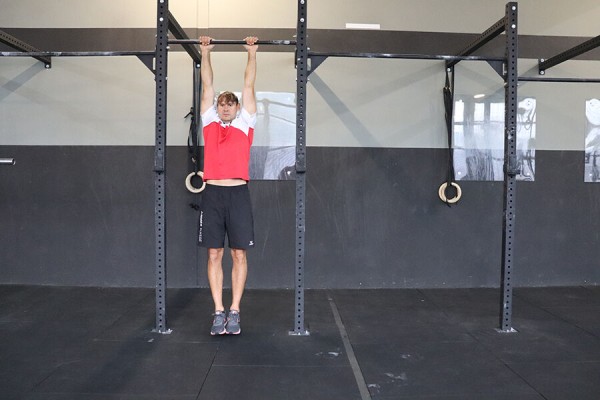
Hold on to the horizontal bar in a hanging position (full body extension, arms stretched out overhead in a high position - passive hang) (the position can be assumed with the help of a bench or a chair), the hands grasp the bar with an overhand grip (palms facing backwards), the arms are positioned shoulder-width apart. Hold the position for as long as possible (hollow position). After the exercise, slowly place your feet back on the chair or bench before releasing your hands from the pole or dropping to the floor to stand.
Attention:
Let your upper body hang still (no swinging; tense your core muscles); arms are fully extended.
Lighten:
Do the exercise for a shorter period of time; use the elastic band as support (place your feet on the band).
Harden:
Additional weight; do the exercise with one arm.
Variant I:
Knee bent.
Variant II:
Grab the bar with a neutral grip or underhand grip.
1 horizontal bar
1 elasticated rubber band ► make the exercise easier (support)
2 weight cuffs/1 weight waistcoat ► make the exercise more difficult (additional weight)
Extension of the arms in a hanging position
Power
Individual work
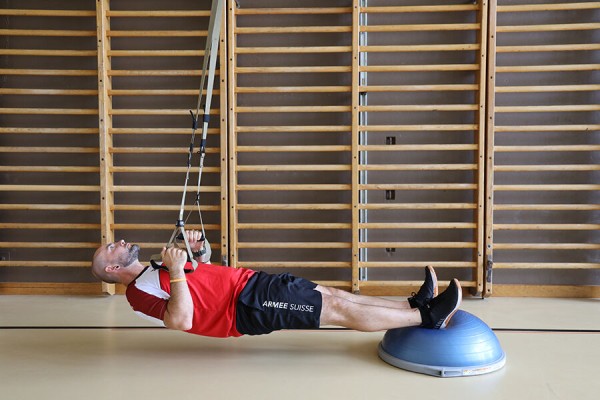
Lie on your back with your legs supported by your heels on the balance hemisphere and your hands gripping the handles of the sling trainer (lower height, hammer grip). Bend your arms to raise your upper body and bring it into a horizontal position. Hold the position.
Attention:
Keep your body taut (no sagging); keep your head in a neutral position.
Lighten:
Let your legs rest on the floor.
Harden:
Heels supported on the balance board; additional weight.
Variation:
Bend and stretch arms (raise and lower upper body).
1 sling trainer
1 balance hemisphere
1 balance board ► to make the exercise more difficult (unstable base)
1 weight waistcoat ► to make the exercise more difficult (additional weight)
Extension of the legs in a hanging position ► hanging knee raise
Power
Individual work
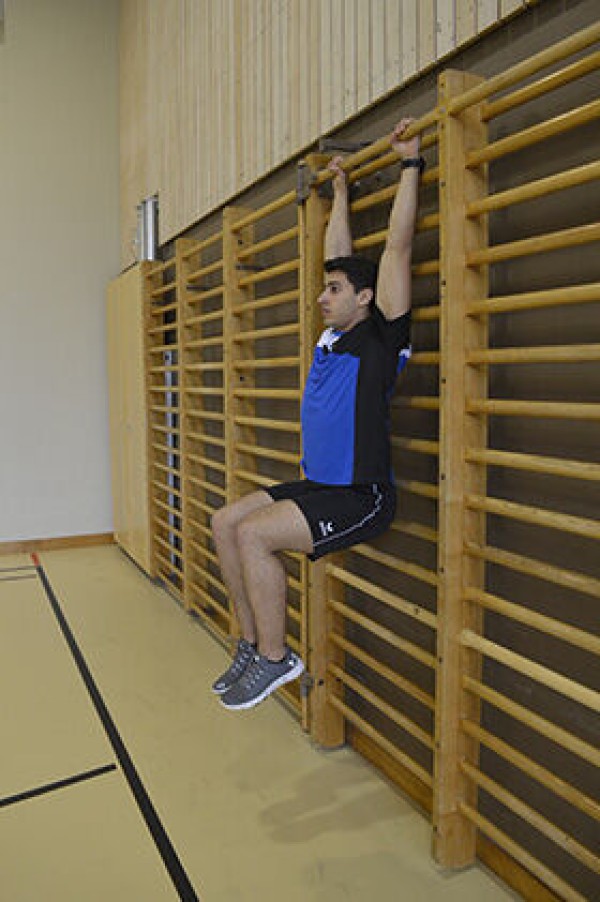
Hanging on the wall bars (back facing the wall bars), body stretched out, legs bent (knees raised to hip height), hold the position.
Attention:
Back always remains against the wall bars.
Lighten:
Lift the knees less high.
Harden:
Additional weight for the legs; stretch the legs.
1 wall bars
1 horizontal bar
2 weight cuffs/1 (medicine) ball (e.g. football, volleyball, basketball) ► make the exercise more difficult (additional weight)
Extension and flexion of the arms / moving the arms upwards while standing (shoulder press) ► shoulder press
Power
Individual work


Stand upright, shoulder-width apart in the centre of the elastic band, with your hands holding one end of the band next to your body at shoulder height, the elbows of your bent arms pointing downwards, stretch your arms straight up next to your ears and bend back to the starting position.
Attention:
Do not arch your back (tighten your stomach).
Lighten:
Choose a rubber band with less resistance.
Harden:
Choose a rubber band with more resistance.
Variation:
Step with your front foot on the centre of the band. Cross the ends of the band and grasp them next to your body (palms facing up). Elbows bent and close to the body. Move your arms up to the sides without moving your shoulders.
1 elasticated rubber band
Extension and flexion of the arms / forearm support ► tricep dip / pillar bridge
Power
Partner work
Exercise both muscle groups ► note the change of position
(= double the time required; for lesson planner see organisation strength: Info button execution)
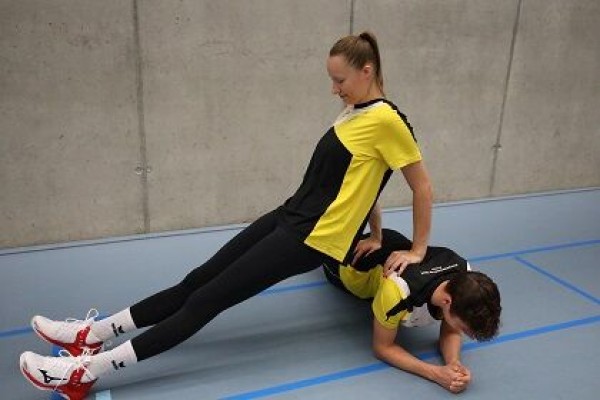
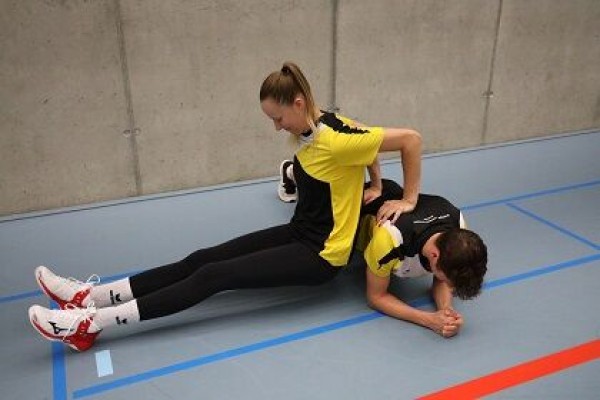
One participant is in the forearm support, the partner supports the upper body from the side (body view of the partners corresponds to the letter "T") with the hands on the partner's back (back facing the partner, arms behind the back, legs stretched). The participant leaning on their partner bends and stretches their arms (lowering and raising the upper body, tricep press).
Attention:
Actively tense the trunk during the forearm support (no sagging). When doing the tricep press, press your elbows together and hold them in place.
Lighten:
Bend your feet closer to your partner/legs, bend your arms less. Forearm support: lower your knees.
Harden:
Additional weight (on the hips); forearm support: Unstable support (for arms and/or legs)
1 weight disc/sandbag ► make the exercise more difficult (additional weight)
1-2 balance cushion/balance board(s) ► make the exercise more difficult (unstable surface)
Extension and flexion of the arms ► biceps curl
Power
Partner work
1 trainee & 1 helper ► note change of position
(= double the time required; for lesson planner see organisation strength: Info button execution)
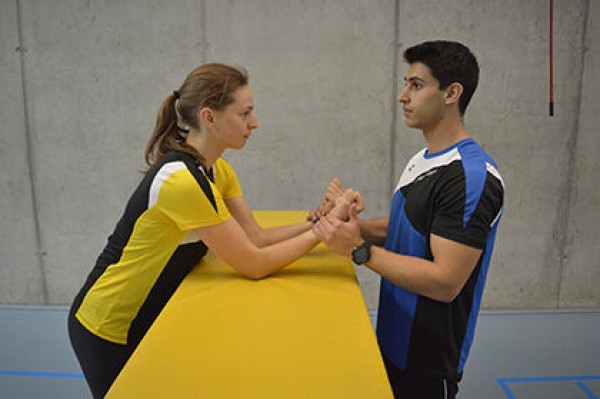
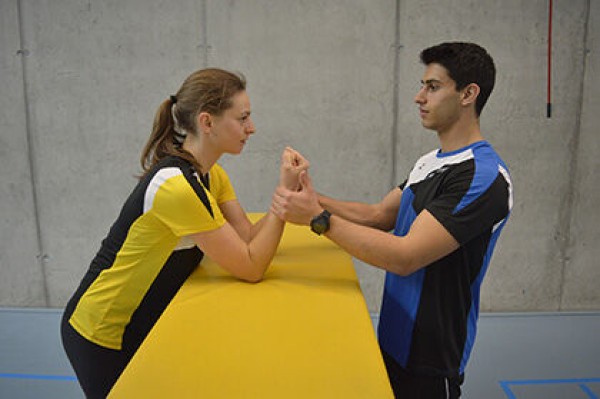
Exerciser: Standing, support elbows on the vaulting box, bend and stretch arms (raise and lower forearms).
Partner: Counteracts the exerciser's movement by holding hands.
Attention:
Always listen to/respond to your partner (adjust pressure/intensity).
Lighten:
Less resistance from your partner.
Harden:
More resistance from your partner.
1 swedish box
Extension and flexion of the arms ► tricep dip
Power
Partner work
1 trainee & 1 helper ► note change of position
(= double the time required; for lesson planner see organization strength: Info button execution)

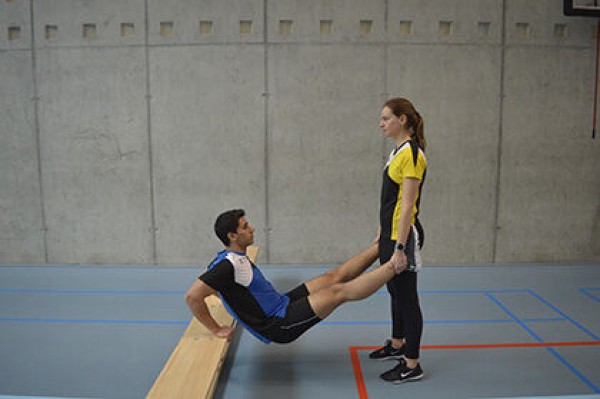
Exerciser: Support your upper body with your hands on a long bench (back facing the bench, arms behind your back), legs stretched out in your line of vision, bend and stretch your arms (lower and raise your upper body, tricep press).
Partner: Hold your partner's feet at hip height in a standing position.
Attention:
Do not straighten your arms in the end position. Elbows point backwards.
Lighten:
Partner lowers the feet to a standing position; place feet on the floor or even bend legs with feet down (without partner); bend arms less.
Harden:
Place additional weight on the hips.
1 long bench
1 weight disc/sandbag ► make the exercise more difficult
Extension and flexion of the arms while standing upright ► db shoulder press / arnold press
Power
Individual work
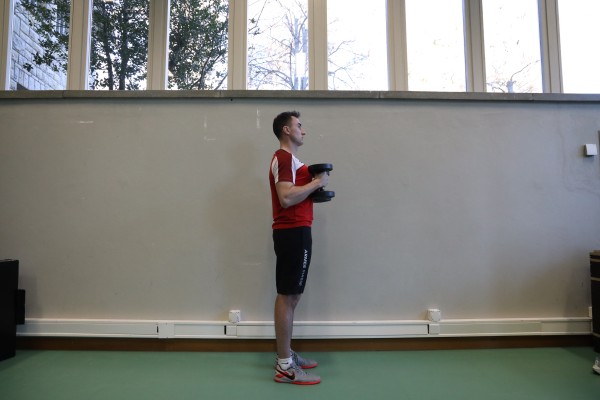
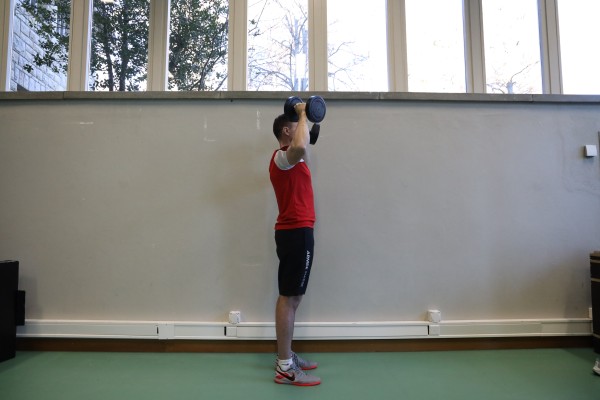
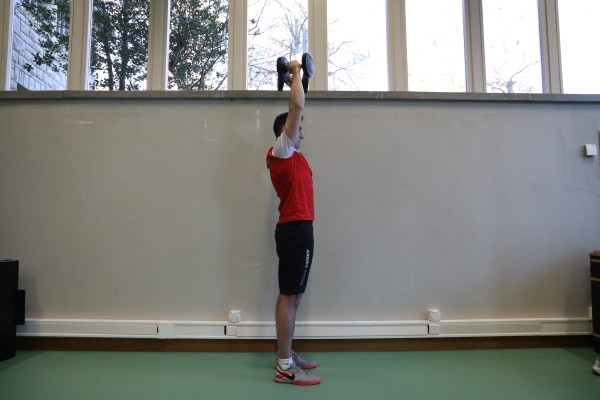
Stand upright with your feet shoulder-width apart and hold the weights in front of your chest with your arms bent. The upper arms are close to the body, the elbows are pointing downwards and the forearms and backs of the hands are pointing forwards. From this position, practically bring the arms together in a circular rotational movement overhead. In the end position, the arms are stretched vertically upwards with the backs of the hands pointing backwards. Reverse the sequence of movements to bring the dumbbells back to the starting position towards your chest.
Attention:
Do not fully straighten your arms, straight back (possibly back against a wall), actively tense your core.
Lighten:
Less weight.
Harden:
More weight.
Variant:
Exercise performed sitting down.
2 dumbbells
Extension und Flexion der Arme im aufrechten Stand ► shoulder press / db shoulder to overhead / db overhead shoulder press
Power
Individual work
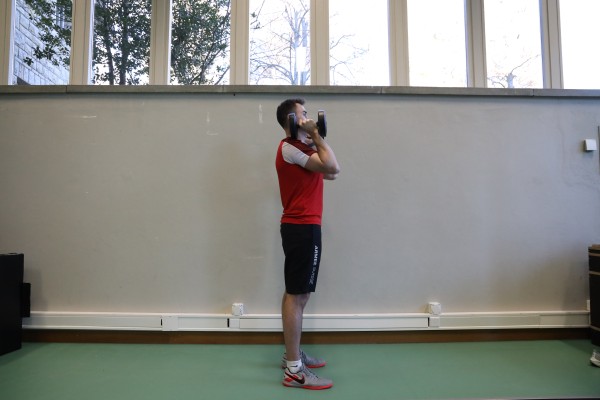
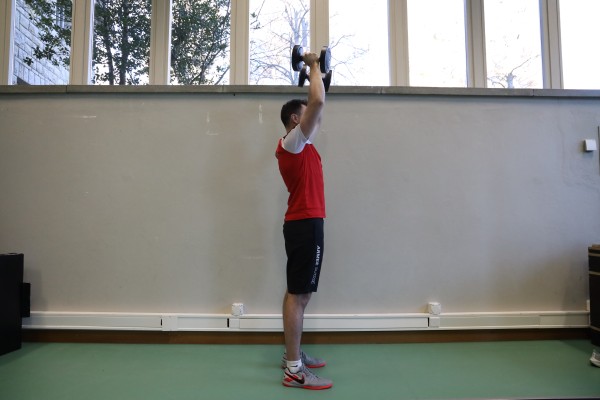
Stand upright with your shoulders shoulder-width apart, hold a dumbbell on each side of your body with your arms bent so that the weights are above your shoulders close to your ears. The elbows point forwards, palms facing each other towards the face (neutral grip). Extend your arms vertically upwards and bend them back to the starting position.
Attention:
Do not fully extend your arms, keep your back straight (possibly back against a wall), actively tense your core.
Lighten:
Less weight.
Harden:
More weight.
Variant I:
Exercise performed in a seated position.
Variant II:
After each exercise, bring your arms/dumbbells together above your head in front of your head (elbows at shoulder height) with your palms facing your face.
2 dumbbells
Extension and flexion of the arms in a lunge (left)
Power
Individual work

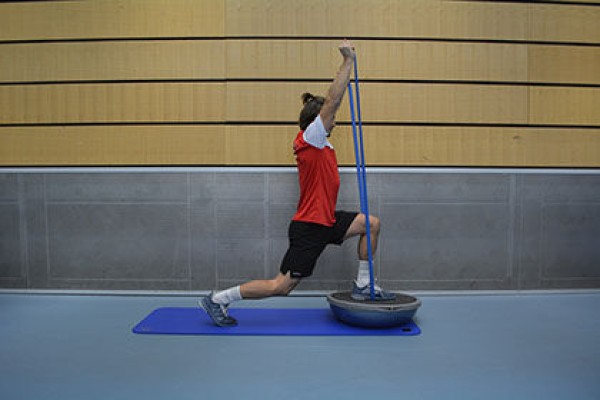
Lunge (left) with the upper body upright, front (left) leg bent (approximately right angle at the knee joint) on a balance cushion/balance ball (possibly placed upside down), back (right) leg bent, with the supporting leg (left) an elasticated rubber band is clamped between the foot and the balance cushion/balance ball. Grasp one side of the elastic band at around stomach height, slowly raise your arms over your head to a high position and back to the starting position.
Attention:
Do not arch your back, tense your core.
Lighten:
Bend your supporting leg less (more upright starting position); choose an elastic band with less resistance; place your supporting leg on the floor.
Harden:
Choose a rubber band with greater resistance.
Variant:
Lift your arms up in front of your body from the holding position (the distance between your arms does not change) or bring your arms together at your sides in an arching movement overhead.
1 balance cushion/balance hemisphere
1 elasticated rubber band
Extension and flexion of the arms in lunge (right)
Power
Individual work
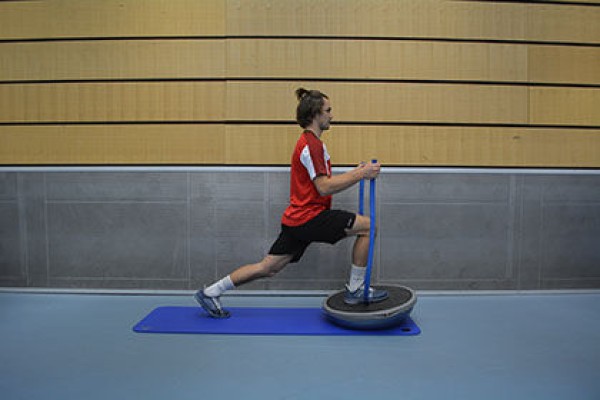
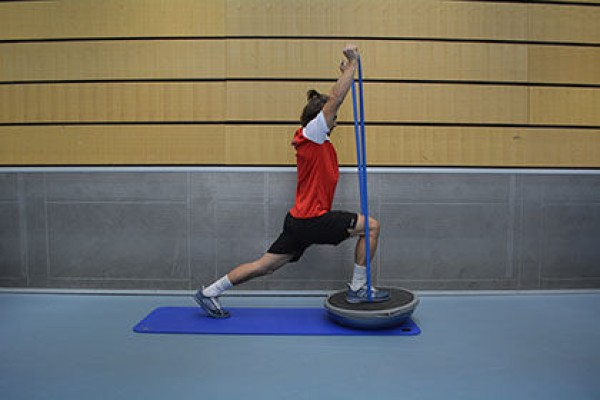
Lunge (right) with upper body upright, front (right) leg bent (approximately right angle in the knee joint) on a balance cushion/balance ball (possibly placed upside down), rear (left) leg bent, with the supporting leg (right) an elasticated rubber leg is clamped between the foot and the balance cushion/balance ball. Grasp one side of the elastic band at around stomach height, slowly raise your arms over your head to a high position and back to the starting position.
Attention:
Do not arch your back, tense your core.
Lighten:
Bend your supporting leg less (more upright starting position); choose an elastic band with less resistance; place your supporting leg on the floor.
Harden:
Choose a rubber band with greater resistance.
Variant:
Lift your arms up in front of your body from the holding position (the distance between your arms does not change) or bring your arms together at your sides in an arching movement overhead.
1 balance cushion/balance hemisphere
1 elasticated rubber band
Extension and flexion of the arms in half kneeling position (left) ► biceps curl
Power
Individual work

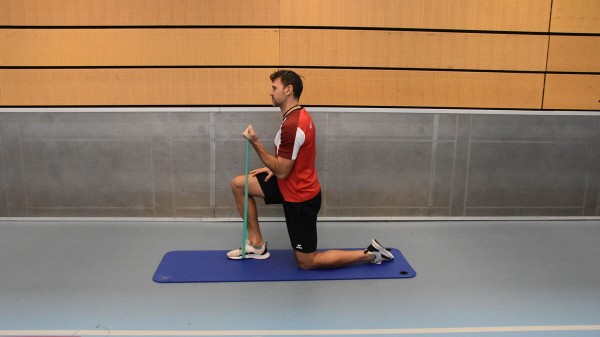
Half kneeling with the upper body tilted slightly forwards, with the (right) foot placed on the floor, an elasticated band is fixed in place. The outstretched left arm on the side of the kneeling (left) leg grasps the elastic band at shin height of the lowered leg. From this position, bend the arm (stretch/tension the elastic band further) by bringing the hand towards the chest. Then stretch your arm back to the starting position.
Attention:
Always keep your back straight (tense your core). The angle of the back and thighs remains unchanged throughout the exercise. Keep your elbows close to your body.
Lighten:
Choose a rubber band with less resistance.
Harden:
Choose a rubber band with more resistance.
Variation:
Grab the band with both arms on the side of the kneeling leg (= organisation 2 exercises).
1 mini-band
Extension and flexion of the arms in half kneeling position (right) ► biceps curl
Power
Individual work


Half kneeling with the upper body tilted slightly forwards, with the (left) foot placed on the floor, an elasticated band is fixed in place. The outstretched right arm on the side of the kneeling (right) leg grasps the elastic band at shin height of the lowered leg. From this position, bend the arm (stretch/tension the elastic band further) by bringing the hand towards the chest. Then stretch your arm back to the starting position.
Attention:
Always keep your back straight (tense your core). The angle of the back and thighs remains unchanged throughout the exercise. Keep your elbows close to your body.
Lighten:
Choose a rubber band with less resistance.
Harden:
Choose a rubber band with more resistance.
Variation:
Grab the band with both arms on the side of the kneeling leg (= organisation 2 exercises).
1 mini-band
Extension and flexion of the arms in half kneeling position ► biceps curl
Power
Individual work

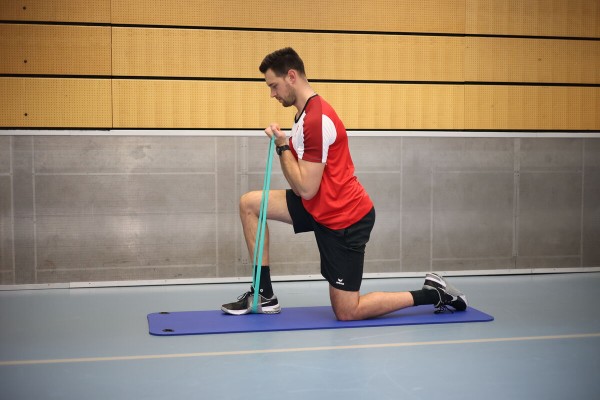
Half kneeling with the upper body leaning slightly forwards, with the (right) foot placed on the floor, an elasticated band is fixed in place. The stretched arms hold the free end of the elastic band on the side of the kneeling leg (left) at shin height of the lowered leg. From this position, bend your arms (stretch/tension the elastic band further) by bringing your hands to your chest. Then stretch your arms back to the starting position. Of course, the exercise can also be performed with the left leg off the ground and the right leg kneeling (if necessary, change position for several rounds).
Attention:
Always make sure your back is straight (keep your core tensed). The angle of the back and thighs remains unchanged throughout the exercise. Keep your elbows close to your body.
Lighten:
Choose a rubber band with less resistance.
Harden:
Choose a rubber band with more resistance.
Variation:
Grab the band with one arm (side of the kneeling leg - change the position of the half-kneeling position to train the other side = organisation 2 exercises).
1 mini-band